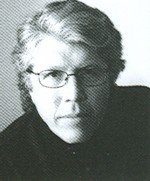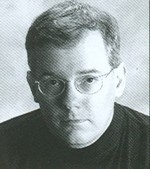|
The Book of the Dead (Warner Books; 2006; $25.95; 454 pp.), by Douglas Preston and Lincoln Child, is the last book in a trilogy, say the authors. Brimstone would be the first of the Pendergast Trilogy (so named for central character, Special Agent Aloysius Pendergast), followed by Dance of Death. (The authors suggest a reading of the second book would increase enjoyment.)

Douglas Preston |
Preston and Child have been writing successful thriller novels since their first, Relic back in 1995. Since then they have co-written eleven adventures, seven starring Pendergast. Individually, they have written several books each such as Preston's Tyrannosaur Canyon and Child's Death Match. But neither has struck upon a character as interesting or enduring as their Southern-accented FBI sleuth.
And sleuth he is, in the finest tradition. Pendergast, although vividly etched, with a well thought out back story and family history that renders him memorable, cannot totally escape from his debt to Sherlock Holmes. This is certainly no slight to the authors or their creativity for there are many detectives, agents, policemen and amateur sleuths about whom the same can be said. It is actually an enormous compliment to Arthur Conan Doyle and his ability to perfect a template for so many future solvers of crimes. |
| Like Holmes, Pendergast is an eccentric. We know this from his distinctive dress preference (generally white clothing), his encyclopedic knowledge, his great deductive reasoning, mastery of psychology, and a talent for make-up and mimicry. And like Holmes, Pendergast has a brother, Diogenes, also a genius and equally adept at the same skills. However, unlike Holmes, Pendergast's brother is evil, an event in his past sending him into the clutches of the dark side.
The Pendergast Trilogy has been concerned with the battle between these two brothers. In the last novel we were left with a cliffhanger, brother Diogenes brilliantly planting evidence only a CSI unit could discover in order to frame big brother Aloysius for several murders. |

Lincoln Child |
The new book begins with Pendergast incarcerated in the escape-proof Herkmoor Correctional Facility. No prisoner or guard knows who he is -- he is known only as A -- or why he is there. Actually, Pendergast doesn't enter the scene until page 114, but a great deal happens before that moment.
A strange package arrives at the New York Museum of Natural History. Yes, it's out old haunting grounds from the first Pendergast adventure The Relic. Without giving away too much of the plot, suffice it to say that this package directly results in the Museum directors deciding to re-open one of their original exhibits, the Tomb of Senef. The exhibit was suddenly closed, actually sealed, and still remains intact within the bowels of the Museum.
| Once again we are plunged into that Preston/Child world of mystery where the possibility of hidden wonders right under our nose exist on a daily basis. In The Relic the Museum was established as a huge hodge-podge of buildings, miles of underground corridors, forgotten passageways and lost arcana. The Reliquary further solidified this image with an underground, contemporary civilization living in the forgotten work areas and abandoned subway tunnels running several stories beneath the streets of New York city.
Many of these notions -- an abandoned pneumatic subway protoype, a private underground subway platform built for the Astors, an underground population -- seem fanciful creations of the authors. Yet they are well-researched facts attested to in film documentaries and an excellent book The Mole People: Life in the Tunnels Beneath New York City in which Jennifer Toth enters the subterranean world of NYC's underground community. (It couldn't hurt that Preston worked in the Museum for eight years, either.)
|
Many of these notions -- an abandoned pneumatic subway protoype, a private underground subway platform built for the Astors, an underground population -- seem fanciful creations of the authors. Yet they are well-researched facts |
And so we are back on the same turf as The Relic, forced underground in a Museum where we know to descend beneath the Earth is to bring to light events best left alone. That the Tomb of Senef has a particularly nasty curse hanging over it doesn't help. Tracing the location of the exhibit and then finding it is like an archaeological hunt and unsealing it bears uncomfortable similarities to the opening of a real tomb. Needless to say, in the world of Preston/Child, no good can come of this.
Yet, there is Nora Kelly, first seen in another well-researched Preston/Child thriller, Thunderhead (Preston has written several non-fiction books on the American Southwest). She reluctantly takes on the job of preparing the new exhibit, staging a state-of-the-art sound and light show in a matter of only a few weeks. Complicating matters is that she is now wed to reporter William Smithback, he whose career was made in The Relic with the Museum monster story. Further muddying the waters is that he believes Pendergast innocent and is investigating leads to that effect.
Smithback isn't the only person who thinks Pendergast an innocent man. Lieutenant Vincent D'Agosta, himself facing disciplinary action for the events taking place in Dance of Death, has insisted all along on the agent’s innocence. He needs to convince his estranged lover, Captain of Homicide Laura Hayward. After all, she's the one who built the case against Pendergast. But she wants nothing to do with him, his attempts to keep her safe interpreted as a betrayal.
The Tomb of Senef hasn't been open for long before the sort of strange things we are accustomed to begin to happen. Quite plausibly, it appears that the mummy of Senef is loose in the Museum. Is Pendergast cleared of murder charges? Does he remain in prison? Will Diogenes triumph? For these answers, read the book.
The suspense, thrills and chills, and foreboding atmosphere of ancient evil prevalent in The Relic, Reliquary and Cabinet of Curiosities are all back in The Book of the Dead. Anyone worried that Preston/Child had written themselves into a corner with their focus on the battle between the two brothers need not have worried.
The mettle of this frail flower is sorely tested with her guardian in prison |
Indeed, the authors have expanded their fictional world. Other familiar characters like Eli Glinn, the head of Effective Engineering Solutions, who first appeared in The Ice Limit is back with his high-tech sci-fi gadgets, as well as Wren, Proctor, Margo Green and someone else who will remain as a surprise. The biggest developments occur with the character Constance Green, Pendergast's tender young ward, confined in the agent's crumbling Beaux Arts mansion on a seemingly deserted stretch of Manhattan's Riverside Drive due to a calamitous event in her life. The mettle of this frail flower is sorely tested with her guardian in prison. |
Fans should be pleased. The novel is well paced, holding off on the re-entry of Pendergast only help builds anticipation. Meanwhile, there are plenty of story and character developments to keep the reader engrossed. Between two major set pieces and another dozen smaller moments, the pages zip past. And while the book has the excitement of a roller coaster ride, it is much more because it concerns characters we care about.
The dust jacket mentions that the authors are working on the next Pendergast novel. One would assume it will be a stand alone, a different adventure outside the province of his brother's evil purvey. Whatever it might be, we can only muse over what wonders we will be offered to savor. In the interim, it might be a good idea to re-read some of the previous books.
|









